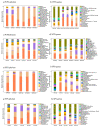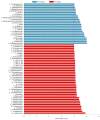Changes in Microbial Communities Using Pigs as a Model for Postmortem Interval Estimation
- PMID: 38004822
- PMCID: PMC10672931
- DOI: 10.3390/microorganisms11112811
Changes in Microbial Communities Using Pigs as a Model for Postmortem Interval Estimation
Abstract
Microbial communities can undergo significant successional changes during decay and decomposition, potentially providing valuable insights for determining the postmortem interval (PMI). The microbiota produce various gases that cause cadaver bloating, and rupture releases nutrient-rich bodily fluids into the environment, altering the soil microbiota around the carcasses. In this study, we aimed to investigate the underlying principles governing the succession of microbial communities during the decomposition of pig carcasses and the soil beneath the carcasses. At early decay, the phylum Firmicutes and Bacteroidota were the most abundant in both the winter and summer pig rectum. However, Proteobacteria became the most abundant in the winter pig rectum in late decay. Using genus as a biomarker to estimate the PMI could get the MAE from 1.375 days to 2.478 days based on the RF model. The abundance of bacterial communities showed a decreasing trend with prolonged decomposition time. There were statistically significant differences in microbial diversity in the two periods (pre-rupture and post-rupture) of the four groups (WPG 0-8Dvs. WPG 16-40D, p < 0.0001; WPS 0-16Dvs. WPS 24-40D, p = 0.003; SPG 0D vs. SPG 8-40D, p = 0.0005; and SPS 0D vs. SPS 8-40D, p = 0.0208). Most of the biomarkers in the pre-rupture period belong to obligate anaerobes. In contrast, the biomarkers in the post-rupture period belong to aerobic bacteria. Furthermore, the genus Vagococcus shows a similar increase trend, whether in winter or summer. Together, these results suggest that microbial succession was predictable and can be developed into a forensic tool for estimating the PMI.
Keywords: forensic science; microbial community; postmortem interval estimation; rupture.
Conflict of interest statement
The authors declare no conflict of interest.
Figures







Similar articles
-
Exploring postmortem succession of rat intestinal microbiome for PMI based on machine learning algorithms and potential use for humans.Forensic Sci Int Genet. 2023 Sep;66:102904. doi: 10.1016/j.fsigen.2023.102904. Epub 2023 Jun 7. Forensic Sci Int Genet. 2023. PMID: 37307769
-
Predicting the postmortem interval of burial cadavers based on microbial community succession.Forensic Sci Int Genet. 2021 May;52:102488. doi: 10.1016/j.fsigen.2021.102488. Epub 2021 Feb 24. Forensic Sci Int Genet. 2021. PMID: 33667880
-
A Pilot Study of Microbial Succession in Human Rib Skeletal Remains during Terrestrial Decomposition.mSphere. 2021 Aug 25;6(4):e0045521. doi: 10.1128/mSphere.00455-21. Epub 2021 Jul 14. mSphere. 2021. PMID: 34259562 Free PMC article.
-
Multimodal Approaches Based on Microbial Data for Accurate Postmortem Interval Estimation.Microorganisms. 2024 Oct 30;12(11):2193. doi: 10.3390/microorganisms12112193. Microorganisms. 2024. PMID: 39597582 Free PMC article. Review.
-
Application of High-throughput Sequencing in Researches of Cadaveric Microorganisms and Postmortem Interval Estimation.Fa Yi Xue Za Zhi. 2018 Oct;34(5):475-481. doi: 10.12116/j.issn.1004-5619.2018.05.004. Epub 2018 Oct 25. Fa Yi Xue Za Zhi. 2018. PMID: 30468048 Review. Chinese, English.
Cited by
-
Gut Microbiota of Ruminants and Monogastric Livestock: An Overview.Animals (Basel). 2025 Mar 6;15(5):758. doi: 10.3390/ani15050758. Animals (Basel). 2025. PMID: 40076043 Free PMC article. Review.
-
The micro CT evaluation of crown and root pulp volume versus dentin thickness in teeth in postmortem interval (PMI).Forensic Sci Med Pathol. 2025 Mar;21(1):71-79. doi: 10.1007/s12024-024-00805-8. Epub 2024 Mar 21. Forensic Sci Med Pathol. 2025. PMID: 38512597 Free PMC article.
-
Unveiling the Forensic Potential of Oral and Nasal Microbiota in Post-Mortem Interval Estimation.Int J Mol Sci. 2025 Apr 6;26(7):3432. doi: 10.3390/ijms26073432. Int J Mol Sci. 2025. PMID: 40244278 Free PMC article.
References
-
- Metcalf J.L., Wegener Parfrey L., Gonzalez A., Lauber C.L., Knights D., Ackermann G., Humphrey G.C., Gebert M.J., Van Treuren W., Berg-Lyons D., et al. A microbial clock provides an accurate estimate of the postmortem interval in a mouse model system. Elife. 2013;2:e01104. doi: 10.7554/eLife.01104. - DOI - PMC - PubMed
Grants and funding
LinkOut - more resources
Full Text Sources

